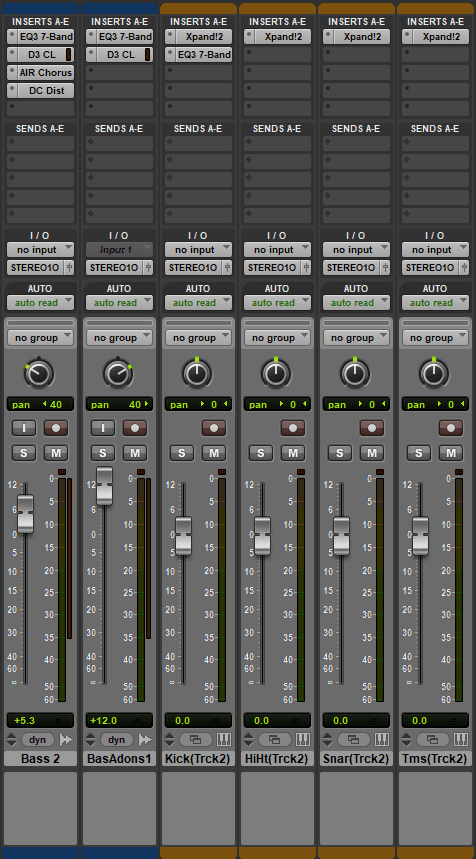
Much like the first song, the mixing in this one was quite easy to do. I chose to pan the lead bass guitar (the distorted one) to the left with the supporting bass guitar panning to the right to help the listener to hear the two tracks, and because otherwise the cleaner, crisper bass guitar track would have been lost in the mix. This way, I was able to do the mixing and mastering needed to produce a properly grunge-like song.
With the grunge theme for the song, it was only obvious to raise the volumes for the bass guitar parts higher than the drums (which I kept at the default volume level) because they would take the majority of the attention with their melodies, riffs and solos, while the drums were simply there to keep rhythm. This change of volume was also done because the bass guitar tracks were recorded rather quietly and needed that boost in volume to be relatively close in volume to the drums (This was also improved upon further in the mastering stage).
The majority of the mastering was focused on the two bass guitar tracks. The main bass guitar track (Bass 2 on the image above) actually started with an equalizer plugin that reduced the 0-100 Hz frequencies, raising the middle frequencies at 1000 Hz and even lifting the frequencies slightly at around 3 kHz. After the EQ, I applied a compressor to reduce the dynamic range between the higher and lower frequencies, and then boosted the gain (input volume) on the compressor plugin to help make the overall sound louder. This was then followed by the AIR Chorus plugin, which took the sound and applied the chorus effect to it. The chorus effect (as described here) is where sounds of similar pitches and volume play at approximately the same time and sound like one sound, and the plugin also allows for many frequencies and sounds to be played at once without boosting the volume of the track. After this, I applied a DC Distortion plugin, which took the sound and amplified it to give it the fuzzy grunge-y guitar sound I hoped for. These changes were done because I aimed at creating a more guitar-like sound which could be suitable for playing riffs as well as a solo. While it would have been easier to just use a guitar and get the sound I wanted, it would not have been meeting my original aim because I wanted each song to have a focus on the bass guitar, and bringing in a guitar would have ruined that.
In regards to the second bass guitar track (Bass Addons 1 on the image), I did the same thing with the EQ and the compressor as I did with the first, producing a much cleaner and crisper bass guitar sound to accompany the fuzzy lead, thus giving the illusion of a guitar and bass guitar combo in the process. I knew this would help immensely because the distorted lead bass guitar was so muddy that, if it was on its own or if the supporting bass was too quiet, it would have not had a supporting riff to help it while it did the solo part, thus making the song feel weaker as a result. With the help of a clean bass guitar playing the riffs on the verses and solo, as well as the chords on the chorus, it helped the song feel a bit more full and covered a larger part of the dynamic range, making the song sound a bit more pleasant to listen to.
The song, prior to the mixing/mastering stage, sounded like this:
The final song now sounds like this:
